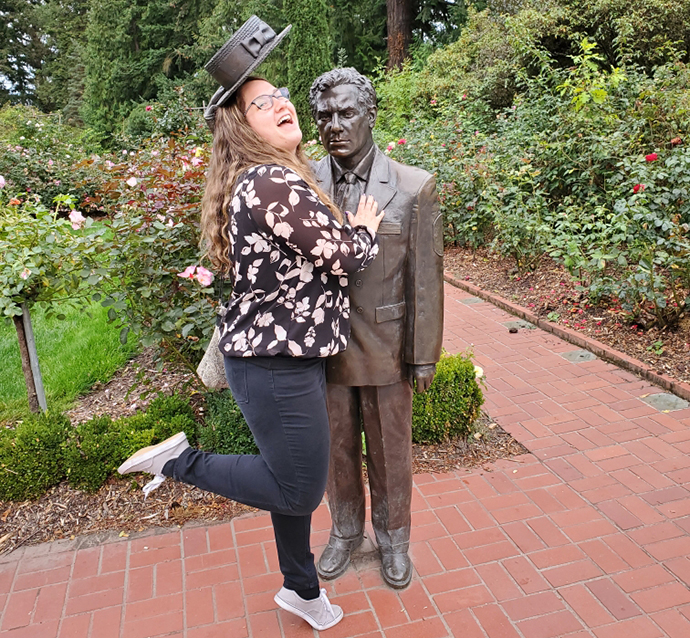
Casey patient JoDee Hambright can see stars for the first time thanks to gene therapy
Just months after receiving gene therapy surgery at OHSU Casey Eye Institute, JoDee Hambright wrote her doctors to say, “I am ecstatic to report that my night vision has improved drastically. I was able to see stars with my naked eye for the first time!”
Hambright was one of the first 14 patients to receive the groundbreaking gene therapy Luxturna at Casey—one of only six sites in the U.S. qualified to offer this vision-saving treatment.
Finding M&M’S
Hambright’s vision problems started early. When she was an infant, her parents noticed she wasn’t making eye contact. Later, when she started walking, she couldn’t adapt to dark lighting. “My parents put M&M’s on the floor, to test my vision,” said Hambright.
She was eventually diagnosed with a defect in the RPE gene, an extremely rare condition which produces the specialized proteins needed for full vision. RPE gene mutations cause night blindness, loss of vision clarity and impaired dark adaptation. Many with the condition lose their sight completely, as adults.
Hambright’s family and teachers in Colorado were very supportive. She always had extra lighting and magnification in the classroom—but school was always a struggle. Hambright remembers not being able to read the white board or recognize friends in the hallways.
By the time she arrived at college, Hambright’s vision was starting to deteriorate. She could only read on the computer or with backlighting. One afternoon, she crashed into a pole while riding her bike. She had started grappling with the reality that she would eventually lose her vision.
Against all odds
And then a news article changed everything: it described a new drug recently approved by the FDA for treating her condition: Luxturna.
“When I read the article I realized, this is just like me,” said Hambright.
To qualify for Luxturna, she needed to confirm that she had RPE65 mutations in both eyes and enough remaining cells in her retina to respond to treatment. She was in luck: The tests were positive. “The odds were astronomical,” she said.
Hambright also had to spend some time adjusting to this new possibility. “I had already been working to accept the fact that I would likely go blind. It was unsettling to start hoping for something different. What if it didn’t work?” she said.
After her initial tests with her retinal specialist in Colorado, Hambright arrived in Portland for more tests, to confirm that she had usable cells. “Those were the longest three days of my life,” said Hambright.
Hambright received the go-ahead in December 2019 and they scheduled the surgery for May 2020. And then Covid-19 hit. Hambright assumed her procedure would be cancelled, but the team at Casey decided that the surgery was essential – it had the potential to transform her life.
During the procedure, the surgeon injected a normal copy of the RPE65 gene into each retina, next to the defective genes. The hope was that the normal genes would take over.
A new relationship with light
Hambright noticed the difference almost immediately. “Within days of surgery I was noticing a whole new relationship with light. Things looked radioactive, glowing and intense. Eventually my brain was able to process the new information.”
Now she’s able to do things she hasn’t done since childhood, like read books; or ever, like seeing stars. “In the mountains on a clear night I feel like I am in a disco ball surrounded by stars and planets,” said Hambright.
“What’s unique about these patients is that they’ve been told their entire life that they’ll eventually go blind. That burden can profoundly influence their life expectations,” said Hambright’s surgeon, Steven Bailey, MD, associate professor of ophthalmology in the OHSU School of Medicine. “This novel treatment gives hope—people have come from as far away as Australia for the procedure.”
Hambright’s success story would not have been possible without the leadership of David J. Wilson, MD, the Paul H. Casey Chair and director of Casey, who anticipated how important gene therapy would become. Philanthropy also played a role: a transformational gift from Paul Casey in 2010 led to an additional $10 million in industry and philanthropic support for gene therapy research.
The team at Casey is excited about the future of gene therapy. Luxturna’s success has the potential to lead to better treatments for a range of eye diseases, including problems like age-related macular degeneration, the leading cause of vision loss in the U.S.
“We’ve had good results with almost every patient,” says Mark Pennesi, M.D., Ph.D., associate professor of ophthalmology and Kenneth C. Swan Professor of Ophthalmology in the OHSU School of Medicine; and chief of the Paul H. Casey ophthalmic genetics division at OHSU Casey Eye Institute. “I love hearing the stories at the one-month post-surgery visit. One patient asked his mom, ‘What are all these lights inside the car?’ He had never seen the dashboard properly. Another parent broke down in tears of joy, telling us that she was finally able to go back to work, because her 12-year-old son could now see well enough to be independent after school.”
Dr. Bailey notes that “This treatment was built on decades of research into understanding ophthalmic genetics, molecular techniques to transfer gene products into targeted host cells, improved retinal imaging techniques, and advances in vitreo-retinal surgery. Now we’re seeing decades of research bear fruit. It’s an exciting time for gene therapy."